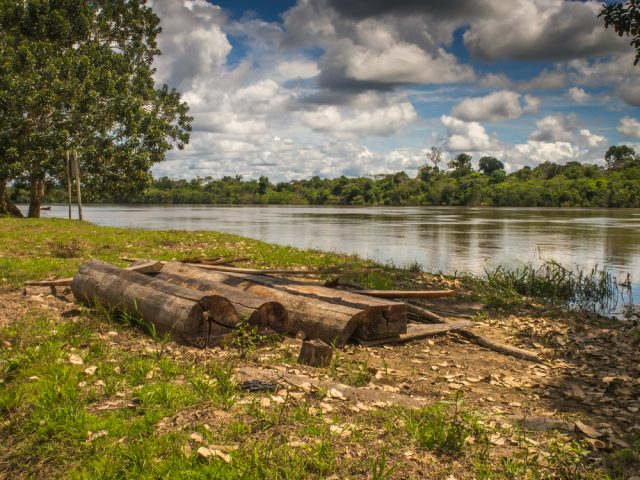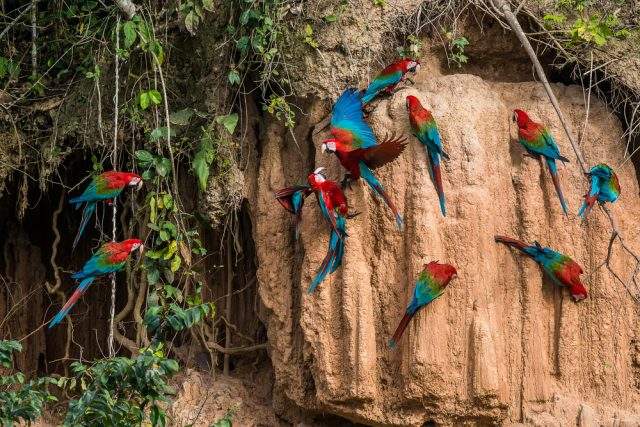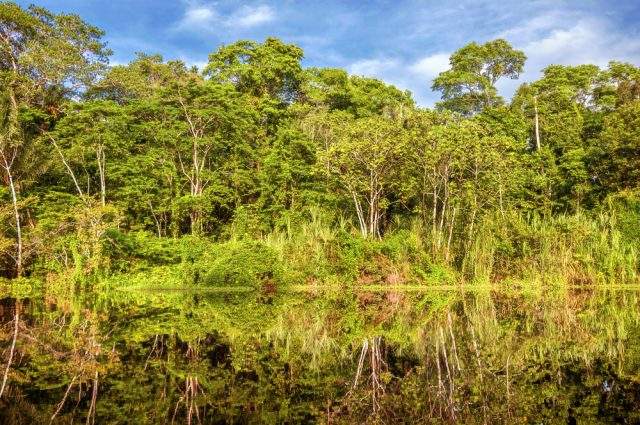At first a quiet rumble and then an all out roar in the canopy before the deluge catches you like hurricane. Thunder. A whirling of wind, and water that descends in sheets turning the forest from green to grey and from dry to the most primal definition of wet. It’s exhilirating.
Walking in the Rainforest
Walking at the front of the pack, Walter, my guide, alternately trudged and hacked, clearing the path of debris that had fallen, or grown in since the last time he had passed. Periodically he would stop and tap something with the point of his machete.
“This tree, this one here,” he’d signal, making sure I was looking in the right place, “It has hard wood, very hard. We use if for making parquet, and for fence posts, or the posts that hold up a house. It’s hard to cut down.”
We talked while we walked about his four years as a military policeman, and about his family in Puerto Maldanado, and about the job he once had that required him to walk two hours through the jungle every morning and night and how that taught him about what he could eat from the jungle.
“This tree,” he tapped again, “This one has a venomous sap. We use it for killing fish, and also for building boats.”
We spent half an hour hunched beneath a Chihuahuaco tree, also known as Ironwood, looking for seeds.
Ironwood trees are disappearing. They take about two to three hundred years to grow to their full heights and their extraordinarily hard wood makes them a commodity. Their role in housing the nests of macaws and the bromeliads that grow high in their branches forming habitat and water pockets for tree frogs and lizards to live and lay eggs in makes them important to the ecosystem.
I stuck close to Walter’s heels as we continued in search of the next Chihuahuaco; they are few and far between in this forest.
Going Off Grid in the Amazon

Without warning, he stopped, turned his face toward the underside of the canopy, shook his machete at the sky and announced, “Lluvia!”
I looked up, skeptically. The sun was shining. I’d left my raincoat and the waterproof bag for the camera in the lodge. Moments later there was a sound in the distance, a quiet SHHHHHHHHHHHH sort of noise. Just as it began to dawn on me what it was, it turned to a roar.
Walter grinned at me, “Run!”
I’d tried to imagine what the Amazon would be like, in the weeks and months leading up to this trip. Two weeks completely off the grid in the rainforest is a long time for a plugged-in girl like me. Two weeks walking, observing, studying, and reflecting.
Peru begs to be explored, and lots of travelers include an excursion into the Amazon as a two-night, three-day, cherry-on-top of a longer trip packed with stops in Cuzco, Machu Picchu, and along the coast. I’d like to suggest flipping that model on its head.
Slowing Way Down

Most of us live in a world that moves fast most of the time. Cars, airplanes, lightning-fast data all whiz around the planet at dizzying speeds.
But the Amazon’s a different world. A world that moves at walking pace, where it’s worth stopping often to look and listen. It’s a world that begins with sunrise and ends with sunset, rest and activity controlled by natural light. Where rhythms are controlled by rain patterns, and residents talk to the trees.
The Amazon is important. It harbors great biodiversity. It’s worth knowing.
Seeing, however, might not be enough. It took me five days to let go of the outside world and eight to settle into the here and now. It wasn’t until the tenth day that I realized that I was totally okay with going to bed at 8 p.m., an hour after dark. It wasn’t until I’d had my day rearranged by a rainstorm and been forced to spend hours in a hammock listening to the music of water on leaves that I finally began to scratch the surface of understanding the gift of the Amazon.
Things I Learned in the Peruvian Amazon

He spent an entire afternoon sitting with a table of giggly girls, sharing his seed beads and teaching them to string them and in the process showed me more about teaching and sharing knowledge with students than any of my education classes ever have.
Headed to Peru? Consider spending as much time in the Amazon as you can manage.
Like this story? Sign up for the Daily Dose and get more BootsnAll in your inbox.
Photo Credits: Cristina Stoian, ostill, klublu, Mirek Nowaczyk,